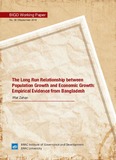The long run relationship between population growth and economic growth: Empirical evidence from Bangladesh
| dc.contributor.author | Zahan, Iffat | |
| dc.date.accessioned | 2022-01-12T08:53:52Z | |
| dc.date.available | 2022-01-12T08:53:52Z | |
| dc.date.copyright | 2016 | |
| dc.date.issued | 2016-09 | |
| dc.identifier.uri | http://hdl.handle.net/10361/15888 | |
| dc.description.abstract | Does population growth induce or depress economic growth? Or, does economic growth encourage or discourage population growth? This is a long-existing debate which has sustained throughout the centuries. This paper investigates the causal relationship between GDP per capita and population growth in Bangladesh. Using the Johansen co-integration test, we find evidence of a long-run relationship between population growth and GDP per capita. Next with a Vector Error Correction Model (VEC), we find a causal direction between the two, which suggests that in Bangladesh population growth actually negatively affects GDP per capita, but not vice versa. Therefore, to some extent, Bangladesh is in the Modern Growth regime stage. Hence, the policy implication is very clear: appropriate measures should be taken in order to arrest population growth. | en_US |
| dc.language.iso | en_US | en_US |
| dc.publisher | BRAC Institute of Governance and Development (BIGD) | en_US |
| dc.relation.uri | https://bigd.bracu.ac.bd/publications/the-long-run-relationship-between-population-growth-and-economic-growth-empirical-evidence-from-bangladesh/ | |
| dc.subject | Cointegration | en_US |
| dc.subject | Causality | en_US |
| dc.subject | Demographic transition | en_US |
| dc.subject | Economic growth | en_US |
| dc.subject | GDP per capita | en_US |
| dc.subject | Malthusian regimes | en_US |
| dc.subject | Population growth | en_US |
| dc.title | The long run relationship between population growth and economic growth: Empirical evidence from Bangladesh | en_US |
| dc.type | Working Paper | en_US |

